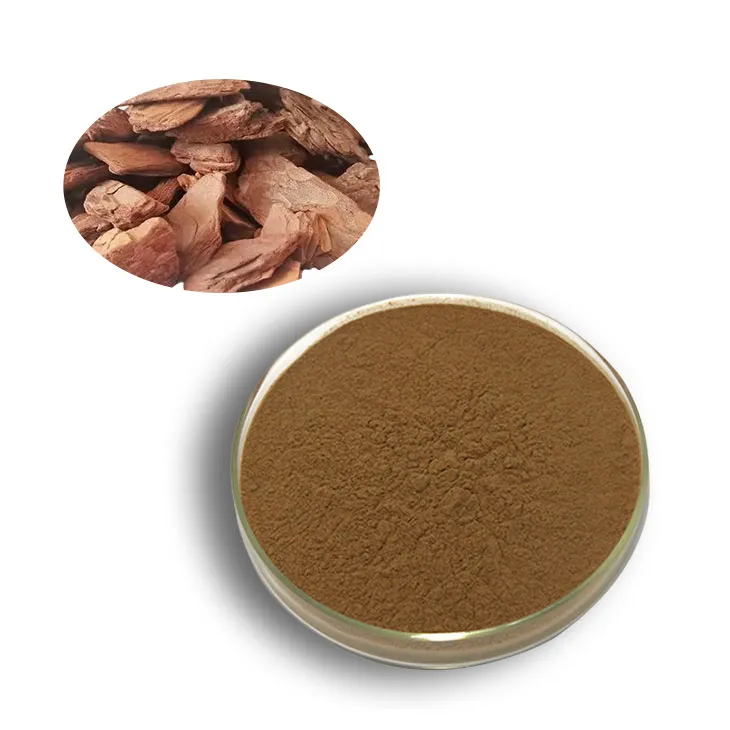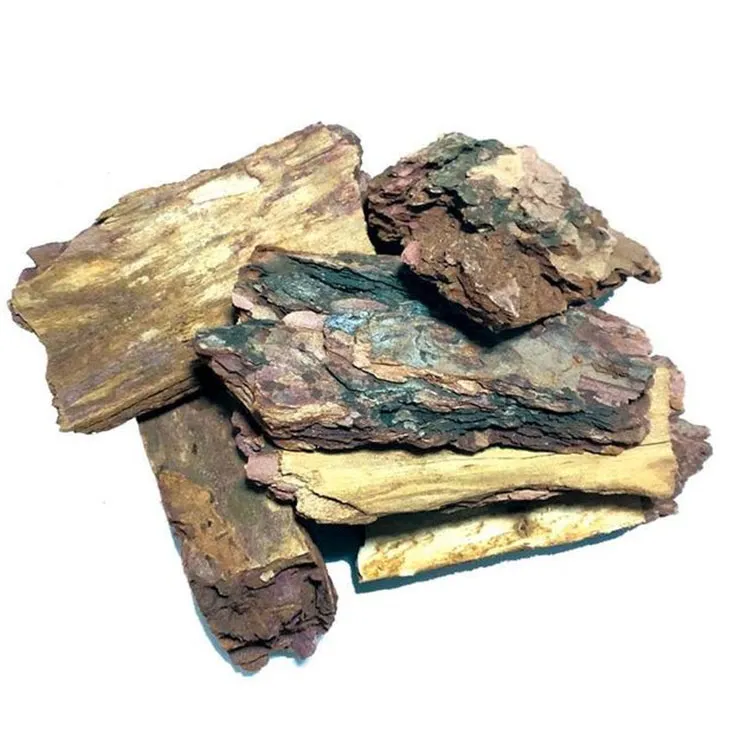- 0086-571-85302990
- sales@greenskybio.com
How to make powder from pine bark extract powder.
2024-11-28

1. Introduction
Pine bark Extract Powder has gained significant popularity in recent years, especially in the natural product and health - related fields. It is rich in various bioactive compounds such as proanthocyanidins, which are known for their antioxidant, anti - inflammatory, and cardiovascular health benefits. Making powder from Pine bark Extract Powder involves several crucial steps, starting from the proper sourcing of pine bark to the final powder formation. This article aims to provide a comprehensive guide on this process.

2. Sourcing of Pine Bark
2.1. Selecting the Right Pine Species
Not all pine species are suitable for extraction. Pinus pinaster and Pinus maritima are among the commonly used species due to their high content of bioactive compounds. When selecting the pine species, it is essential to consider factors such as local availability, legal regulations regarding harvesting, and the quality of the bark. For example, in some regions, certain pine species may be protected, and harvesting them without proper authorization is illegal.2.2. Harvesting Time
The time of harvesting can significantly impact the quality of the pine bark extract. Generally, it is advisable to harvest pine bark during the dormant season. This is when the tree's metabolism is slow, and the concentration of bioactive compounds in the bark is relatively high. For instance, in temperate regions, late autumn to early spring is often considered the best time for harvesting pine bark.2.3. Quality Control of Sourced Pine Bark
Once the pine bark is harvested, strict quality control measures should be implemented. This includes checking for any signs of disease, insect infestation, or contamination. The bark should be free from mold, chemicals, and other impurities. Visual inspection can be the first step, followed by laboratory tests if necessary to ensure that the sourced pine bark meets the required quality standards.
3. Extraction Process to Obtain Active Components
3.1. Pretreatment of Pine Bark
Before extraction, the pine bark needs to be pretreated. This involves cleaning the bark to remove any dirt, debris, or loose outer layers. The bark can be washed with clean water and then dried. Drying can be done either naturally in a well - ventilated area or using a low - temperature drying oven. The dried pine bark should be ground into small pieces or powder to increase the surface area for extraction.3.2. Selection of Extraction Solvent
The choice of extraction solvent is crucial for obtaining the active components from the pine bark. Ethanol and water are commonly used solvents. Ethanol - water mixtures are often preferred as they can effectively extract a wide range of bioactive compounds. The ratio of ethanol to water can vary depending on the specific requirements of the extraction. For example, a 50:50 ethanol - water mixture may be suitable for extracting proanthocyanidins.3.3. Extraction Methods
There are several extraction methods available, including maceration, percolation, and Soxhlet extraction.- Maceration: In this method, the ground pine bark is soaked in the extraction solvent for a certain period, usually several days to weeks. The mixture is stirred occasionally to ensure good contact between the bark and the solvent. After the soaking period, the solvent containing the extracted compounds is separated from the solid residue.
- Percolation: This involves passing the extraction solvent through a column filled with the ground pine bark at a slow and controlled rate. The solvent continuously extracts the active components as it percolates through the bark. This method can be more efficient than maceration in terms of extraction time and yield.
- Soxhlet extraction: Soxhlet extraction is a more automated and continuous extraction method. The ground pine bark is placed in a Soxhlet extractor, and the extraction solvent is continuously recycled through the bark. This method is highly effective for extracting lipophilic compounds and can ensure a more complete extraction of the bioactive components.
3.4. Concentration of the Extract
After the extraction process, the resulting extract is usually in a diluted form. To obtain a more concentrated form of the pine bark extract, the solvent needs to be removed. This can be done using evaporation techniques such as rotary evaporation. The rotary evaporator operates under reduced pressure, which allows the solvent to be evaporated at a lower temperature, thus protecting the bioactive compounds from degradation.
4. Transformation into Powder
4.1. Drying of the Concentrated Extract
The concentrated pine bark extract still contains some moisture. To transform it into powder, further drying is required. Freeze - drying or spray - drying can be used for this purpose.- Freeze - drying: Also known as lyophilization, freeze - drying involves freezing the concentrated extract and then removing the water vapor under vacuum. This method is gentle and can preserve the bioactive compounds well. However, it is relatively expensive and time - consuming.
- Spray - drying: In spray - drying, the concentrated extract is sprayed into a hot air stream. The water in the extract evaporates quickly, leaving behind a powder. Spray - drying is a more cost - effective and faster method compared to freeze - drying, but it may cause some minor degradation of the bioactive compounds if not properly controlled.
4.2. Grinding and Milling
Once the dried extract is obtained, it may need to be further ground or milled to obtain a fine powder. A mortar and pestle can be used for small - scale production, while for larger quantities, industrial - grade grinders and mills are available. The powder should be of a uniform particle size for better quality and usability.4.3. Quality Assurance of the Powder
After the powder is formed, quality assurance tests should be carried out. This includes testing for the content of bioactive compounds, particle size distribution, moisture content, and microbiological contamination. High - performance liquid chromatography (HPLC) can be used to analyze the content of proanthocyanidins and other bioactive components. The powder should meet the required quality specifications for use in various applications such as dietary supplements or cosmetics.5. Conclusion
Making powder from Pine bark Extract Powder is a complex process that requires careful attention to each step, from sourcing the pine bark to transforming the extract into powder. By following the proper procedures for sourcing, extraction, and powder formation, it is possible to produce high - quality pine bark extract powder with consistent bioactive compound content. This powder can then be used in a variety of applications in the natural product and health - related fields, contributing to the development of products with potential health benefits.
FAQ:
Question 1: Where can we source high - quality pine bark?
High - quality pine bark can be sourced from sustainable forests or from forestry by - products. It is important to ensure that the source is legal and follows environmental regulations. Some commercial suppliers also provide pine bark that has been pre - selected for extraction purposes. Additionally, pine trees that are not affected by diseases or pests are preferred as they are more likely to yield better quality bark for extraction.
Question 2: What are the main active components in pine bark extract?
The main active components in pine bark extract are proanthocyanidins. These are a class of polyphenols that have antioxidant properties. They are believed to have various health benefits such as reducing inflammation, improving blood circulation, and protecting cells from oxidative damage. Other components may also be present in smaller amounts, including flavonoids and phenolic acids, which can also contribute to the overall biological activity of the extract.
Question 3: What is the typical extraction process for pine bark extract?
The typical extraction process for pine bark extract involves several steps. First, the pine bark is collected and cleaned to remove any impurities such as dirt, debris, and other foreign materials. Then, it is usually dried to reduce moisture content. After that, a solvent is used to extract the active components. Commonly used solvents include water, ethanol, or a combination of both. The extraction can be carried out using techniques such as maceration (soaking the bark in the solvent for a period of time), percolation (slowly passing the solvent through the bark), or Soxhlet extraction (a more continuous extraction method). Once the extraction is complete, the solvent is removed, usually through evaporation or distillation, leaving behind the pine bark extract.
Question 4: How can we ensure the safety of pine bark extract powder?
To ensure the safety of pine bark extract powder, several steps should be taken. Firstly, the source of the pine bark should be verified to be free from contaminants such as pesticides, heavy metals, and harmful microorganisms. During the extraction process, strict quality control measures should be implemented to ensure that the solvents used are of high purity and that the extraction conditions are optimized to avoid the formation of harmful by - products. After extraction, the powder should be tested for purity, potency, and safety. This can include tests for microbial contamination, heavy metal content, and chemical composition. Additionally, proper storage conditions, such as in a cool, dry place away from sunlight, should be maintained to prevent degradation of the powder.
Question 5: What equipment is needed to make pine bark extract powder?
The equipment needed to make pine bark extract powder includes items for the extraction process and for powder formation. For the extraction, you may need a drying oven to dry the pine bark, containers for the solvent - bark mixture (such as glass jars for maceration or a Soxhlet apparatus for Soxhlet extraction), a filtration system to separate the extract from the bark residue, and an evaporation or distillation setup to remove the solvent. For powder formation, a grinder or mill is required to grind the dried extract into a fine powder. Additionally, scales for measuring the amounts of bark and solvents, and thermometers for monitoring the temperature during extraction and drying processes may also be needed.
Related literature
- Pine Bark Extract: Properties, Applications, and Extraction Methods"
- "The Science behind Pine Bark Extract Powder Production"
- "Optimizing the Extraction of Active Components from Pine Bark for Powder Preparation"
- ▶ Hesperidin
- ▶ Citrus Bioflavonoids
- ▶ Plant Extract
- ▶ lycopene
- ▶ Diosmin
- ▶ Grape seed extract
- ▶ Sea buckthorn Juice Powder
- ▶ Fruit Juice Powder
- ▶ Hops Extract
- ▶ Artichoke Extract
- ▶ Mushroom extract
- ▶ Astaxanthin
- ▶ Green Tea Extract
- ▶ Curcumin
- ▶ Horse Chestnut Extract
- ▶ Other Product
- ▶ Boswellia Serrata Extract
- ▶ Resveratrol
- ▶ Marigold Extract
- ▶ Grape Leaf Extract
- ▶ New Product
- ▶ Aminolevulinic acid
- ▶ Cranberry Extract
- ▶ Red Yeast Rice
- ▶ Red Wine Extract
-
Feverfew Extract
2024-11-28
-
Apricot Powder
2024-11-28
-
Peppermint Oil
2024-11-28
-
Hawthorn powder
2024-11-28
-
Polygonum Cuspidatum Extract
2024-11-28
-
Cocoa Extract
2024-11-28
-
Lemon Extract
2024-11-28
-
Almond Extract Powder
2024-11-28
-
Avocado Extract Powder
2024-11-28
-
Carrageenan Extract Powder
2024-11-28





















